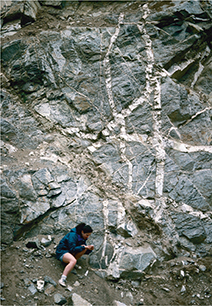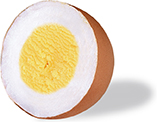The modern science of geology began in the late 1700s. James Hutton, a Scottish physician and farmer, made observations of rocks that he could explain only if Earth were far older than most people had imagined. He observed that some rocks were made of particles that came from older rocks. Hutton realized that Earth's surface had changed gradually over time.
From his observations, Hutton developed the principle of uniformitarianism. Uniformitarianism is the idea that the geologic processes that operate today also operated in the past. Thus, ancient rocks can be understood by observing present-day geologic processes. According to the principle of uniformitarianism, dramatic features such as mountains and canyons are the result of geologic processes that work very slowly over long periods of time.
Figure 2 This geologist is examining the rocks that make up the side of a canyon.

A Cross Section of Earth
Since Hutton's time, geologists have learned a great deal about Earth's structure. Earth's surface and interior can be compared to a hard-boiled egg, such as the one shown in Figure 3. Beneath an egg's hard outer shell is a layer of egg white that surrounds the yolk at the center. Earth has a similar layered structure.  Earth can be divided into three main layers—the crust, mantle, and core—based on the materials that make up each layer. This layering is largely due to differences in density.
Earth can be divided into three main layers—the crust, mantle, and core—based on the materials that make up each layer. This layering is largely due to differences in density.
Physical conditions in Earth's interior vary from layer to layer. Temperature and pressure in Earth's interior increase with depth. As the temperature and pressure increase, the properties of the materials inside Earth also change.
The Crust
The rocky outer layer of Earth is the crust. Like the shell of an egg, Earth's crust is thin compared to its other layers. Much of the crust is made up of silicates, rocks made of compounds of silicon and oxygen. Silicates often contain metals such as aluminum, iron, or calcium.
Figure 3 Earth's structure is similar to that of a hard-boiled egg.
Using Analogies Which of Earth's layers corresponds to the shell of the egg?

There are two different types of crust: continental crust and oceanic crust. Continental crust, the rock that makes up the continents, consists mainly of less-dense rocks such as granite. Continental crust averages about 40 kilometers in thickness, although it ranges in thickness from about 8 to 75 kilometers. It is thickest under mountain chains such as the Himalayas. The rock that makes up the ocean floor is oceanic crust. Oceanic crust is composed mostly of dense rocks like basalt. Oceanic crust is about 7 kilometers thick on average, and so is much thinner than continental crust.





